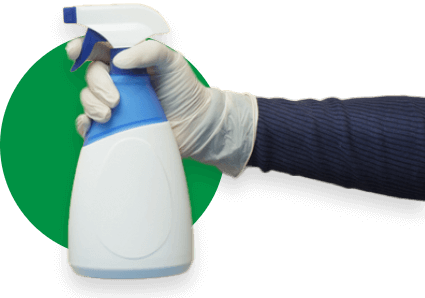Maintaining pristine and pathogen-free spaces is a top priority for businesses throughout Dallas, from dynamic office environments to sensitive healthcare settings. This isn’t just about wiping surfaces; it’s about deploying the correct chemical warfare against microscopic threats. At Dallas Janitorial Services, we know that effective disinfecting services depend on understanding the difference between cleaning and disinfecting and choosing the right strength of solution, depending on the specific area that needs it, whether the job calls for a low-level or high-level disinfectant. Understanding these distinctions is essential for developing effective cleaning procedures that protect everyone in the Dallas community.
What Is Low-Level Disinfection?
Low-level disinfection inactivates most bacteria, some viruses, and some fungi but typically doesn’t kill bacterial spores or mycobacteria. It’s designed for routine cleaning and sanitization of non-critical surfaces and equipment that only come into contact with intact skin.
Common low-level disinfectant uses include daily cleaning of surfaces in general offices, classrooms, restrooms, and common areas in commercial buildings. In healthcare settings, they are used for non-critical medical equipment like stethoscopes, blood pressure cuffs, and examination tables. Examples of common low-level disinfectants include quaternary ammonium compounds (often found in everyday household cleaners like Lysol) and some phenolic compounds.
While effective for general sanitation, low-level disinfectants have limitations. They aren’t designed to eliminate resistant pathogens like Mycobacterium tuberculosis (the bacterium causing tuberculosis), nor are they effective against bacterial spores (highly resilient forms of bacteria) or certain non-enveloped viruses. Therefore, a higher level of disinfection is required for environments with a higher risk of transmitting more resilient pathogens.
What Is High-Level Disinfection?
High-level disinfection (HLD) is a much more potent process that eliminates all microorganisms, except a few bacterial spores. This makes it a critical step for reprocessing medical devices that come into contact with mucous membranes or non-intact skin.
The primary use of HLD is in healthcare settings, particularly for reprocessing “semi-critical” medical equipment. These devices come into contact with mucous membranes or non-intact skin but don’t ordinarily penetrate sterile tissue. Examples include endoscopes, bronchoscopes, and respiratory therapy equipment. HLD is also crucial for specific “critical” equipment when sterilization (which kills all microorganisms, including spores) isn’t feasible.
Common high-level disinfectant examples include glutaraldehyde, ortho-phthalaldehyde (OPA), and hydrogen peroxide. While bleach can be a very effective disinfectant, its classification as high-level depends on concentration and contact time, and it’s often more challenging to use safely and effectively for sensitive medical instruments. The efficacy of high-level disinfectants extends to a broad spectrum of bacteria, viruses (including non-enveloped viruses), fungi, and even some bacterial spores, making them essential for preventing healthcare-associated infections.
5 Key Differences: High-Level vs Low-Level Disinfection
Understanding the fundamental distinctions between these two levels of disinfection isn’t just about technical definitions; it’s vital for making informed choices that directly impact health and safety. The methods, the pathogens they target, and the environments where they’re appropriately used vary significantly. Grasping these core differences is important for any facility manager or healthcare professional looking to implement truly effective and responsible cleaning protocols.
Here are the five fundamental differences between low-level and high-level disinfection, broken down feature by feature.
1. Efficacy Against Pathogens
- Low-Level Disinfection: Targets most bacteria, some viruses, and some fungi. It is not effective against resilient threats like bacterial spores or mycobacteria (e.g., Mycobacterium tuberculosis).
- High-Level Disinfection: Eliminates all microorganisms, including bacteria, viruses, and fungi, with the exception of a small number of highly resistant bacterial spores.
2. Application Methods
- Low-Level Disinfection: Typically applied using simple methods like spray-and-wipe for general surface cleaning.
- High-Level Disinfection: Requires more specialized methods, such as immersing items for a specific contact time or using automated reprocessors, especially for medical equipment.
3. Dwell Times (Contact Time)
- Low-Level Disinfection: Requires a much shorter dwell time, generally between 1 to 10 minutes, for the disinfectant to be effective.
- High-Level Disinfection: Demands a significantly longer dwell time to ensure efficacy, often ranging from 20 to 90 minutes, depending on the specific disinfecting agent and the pathogen being targeted.
4. Safety Considerations
- Low-Level Disinfection: Is less hazardous to use. General Personal Protective Equipment (PPE), such as gloves, is typically sufficient.
- High-Level Disinfection: Is significantly more hazardous and requires strict safety protocols. This includes the use of comprehensive PPE like gloves and eye protection, as well as ensuring the area is well-ventilated.
5. Recommended Use Cases
- Low-Level Disinfection: Ideal for non-critical surfaces and equipment in environments like general offices, schools, homes, and for non-critical medical items (e.g., stethoscopes).
- High-Level Disinfection: Reserved for healthcare settings to disinfect semi-critical and some critical medical equipment that comes into contact with mucous membranes or non-intact skin.
Working with a professional janitorial company that specializes in commercial disinfection ensures these protocols are not only understood but expertly executed, utilizing the right products and techniques for each specific area and risk level. This partnership provides peace of mind, knowing that your environment is not just superficially clean but truly protected against a wide range of harmful pathogens, safeguarding the well-being of occupants and maintaining regulatory compliance.
Choosing the Right Disinfectant Level for Your Business
Choosing the ideal disinfectant level for your business can feel like a complex decision, but it’s critical for effective germ control and occupant safety. It’s not a one-size-fits-all solution; what works for a doctor’s office is likely overkill for a typical commercial space. To help you make the right choice, here’s a step-by-step guide for determining the appropriate disinfection level for your specific environment and needs:
Step 1: Identify Your Facility Type
The type of building you manage heavily influences the level of disinfection required. Different environments present varying levels of pathogen risk and contact surfaces, dictating whether you need a routine clean or a more aggressive germ-killing approach.
Medical Clinics & Hospitals:
High-level disinfection is crucial for semi-critical and critical medical devices that contact mucous membranes or non-intact skin. A combination of low-level and intermediate-level disinfectants will likely be used for environmental surfaces within these facilities, adhering strictly to CDC disinfection guidelines to prevent healthcare-associated infections. For instance, detailed protocols similar to those used for dental clinic disinfection methods ensure that all areas, from patient rooms to waiting areas, meet stringent hygiene standards.
Corporate Offices & Commercial Buildings:
In general office settings, retail spaces, and other commercial buildings, low-level disinfectants are typically sufficient for routine cleaning of desks, doorknobs, breakrooms, and other common touchpoints. The primary focus here is maintaining a consistently clean environment for daily operations. However, during flu seasons or local outbreaks of highly contagious illnesses, implementing office disinfecting techniques that include more frequent cleaning protocols and potentially broader-spectrum (intermediate-level) disinfectants might be considered for enhanced protection. This proactive approach helps reduce the spread of common colds and seasonal flu, ensuring a healthier workspace.
Educational Facilities (Schools & Universities):
Schools and universities are high-traffic environments where germs can spread quickly among students and staff, so knowing the best practices for disinfecting schools will save a lot of headaches and absences. For most daily cleaning, low-level disinfectants are appropriate for surfaces like desks, chairs, and common areas. However, given the close contact among children and often less rigorous hygiene practices, special attention should be paid to frequent disinfection of high-touch surfaces like doorknobs, light switches, and shared learning materials. Implementing stricter protocols with intermediate-level disinfectants becomes vital during outbreaks of illnesses to control contagion effectively.
Industrial & Manufacturing Facilities
The disinfection needs in industrial or manufacturing settings can vary greatly depending on the processes and materials involved. Low-level disinfectants are usually adequate for general administrative areas, restrooms, and common break spaces, similar to corporate offices. However, suppose the facility involves food processing, pharmaceuticals, or other sensitive operations. In that case, specific, rigorous disinfection and sanitization protocols potentially involving high-level or even sterilization methods for particular equipment will be required to meet stringent regulatory standards and prevent contamination. This often includes specialized floor disinfection techniques and comprehensive sanitation schedules tailored to the production environment.
Step 2: Assess the Type of Pathogens Present
Once you’ve identified your facility type, the next crucial step is to consider the specific microbial threats you aim to eliminate. Not all germs are created equal, and their varying resilience dictates the strength of disinfectant required.
For Everyday Germs and Common Contaminants
Low-level disinfection is usually adequate if your primary concern is maintaining general hygiene and preventing the spread of common illnesses (like the cold, flu, or typical bacteria found on everyday surfaces). These disinfectants are effective against many vegetative bacteria, enveloped viruses (like influenza), and some fungi. They are perfect for routine sanitization in less critical environments.
For More Resilient or Specific Threats
The need for a stronger approach becomes clear when the risk from more robust or specific pathogens is higher.
- Intermediate-Level Disinfection: This level bridges the gap and is effective against tougher bacteria like Mycobacterium tuberculosis (the organism causing TB) and non-enveloped viruses (harder to kill than enveloped viruses). This might be necessary in areas with suspected or confirmed cases of certain respiratory illnesses or in laboratories.
- High-Level Disinfection: This is the non-negotiable standard when dealing with highly resistant pathogens, including bacterial spores (like Clostridioides difficile or C. diff) and other formidable microorganisms. High-level disinfection is essential for environments where invasive medical instruments are processed or where there’s a significant risk of transmitting serious infections. It provides a much broader kill spectrum, crucial for preventing hospital-acquired infections.
Understanding the specific “enemy” helps ensure you’re not under-disinfecting and leaving threats behind, nor over-disinfecting when a less aggressive method would suffice.
Step 3: Evaluate Cleaning Frequency and Potential Exposure Risks
Even with the right disinfectant for the job, how often you clean and the specific risks of exposure in your facility are paramount. This step is about understanding the dynamics of germ spread in your unique environment.
High-Traffic Areas
Surfaces touched often by multiple people, like doorknobs, light switches, elevator buttons, shared equipment, and countertops, serve as common pathways for germ transmission. These “high-touch surfaces” require more frequent disinfection, even if you’re using low-level disinfectants. This continuous effort isn’t just about appearances; it significantly helps break the transmission chain, reducing the viral and bacterial load that can accumulate throughout the day. Consider areas like reception desks in corporate offices, cafeteria tables in schools, or handrails in industrial settings as prime candidates for frequent attention.
Cross-Contamination
The concept of cross-contamination is central to effective disinfection frequency. This occurs when germs are inadvertently transferred from a contaminated surface or item to a clean one, often via hands, cleaning cloths, or equipment. For example, using the same cloth to wipe a restroom counter and an office desk without proper sanitization can spread pathogens. Frequent cleaning and proper cleaning techniques (like cleaning from clean to dirty areas and regularly changing cleaning cloths) minimize this risk.
Vulnerability of Occupants
Always consider the health profile of the individuals in your space, as the potential impact of germ transmission can vary dramatically depending on the population.
- Highly Vulnerable Populations: In environments like healthcare facilities, nursing homes, or childcare centers, where occupants might be immunocompromised, elderly, very young, or have underlying health conditions, the consequences of infection are far more severe. These settings demand rigorous and often more frequent disinfection schedules, as even a seemingly low risk of transmission can have serious outcomes.
- General Public/Workforce: While occupants may be generally healthy in typical office environments or retail spaces, high occupancy or periods of widespread illness (like flu season) still warrant increased cleaning frequency to protect the broader community and minimize absenteeism.
Real-World Scenario Planning
To optimize your disinfection, step back and envision how your facility operates daily. Consider how people move through your space and interact with surfaces, identifying key patterns and potential hotbeds for germ transmission.
- Activity-Based Disinfection: Consider specific activities that generate higher risks. For example, common areas where food is consumed, like breakrooms, cafeterias, or kitchenettes, will likely require disinfection both before and after use or even continuous wipe-downs throughout peak hours. Food residues can create breeding grounds for bacteria, and shared eating surfaces are prime spots for germ exchange.
- Shared Resources: If your facility utilizes shared tools or equipment—whether office supplies, machinery in an industrial setting, or educational instruments—these should ideally be disinfected between users. This prevents the direct transfer of pathogens from one person to another via objects.
- Peak Traffic Times: Are there specific times when foot traffic is highest, such as morning arrivals, lunch breaks, or shift changes? These might be ideal times for more intensive cleaning rounds on high-touch surfaces. Targeting disinfection during these periods can significantly reduce the cumulative germ load.
- Event-Driven Cleaning: Beyond daily routines, consider events like meetings, conferences, or large gatherings. These occasions dramatically increase surface contact and should prompt additional disinfection efforts immediately following their conclusion.
By strategically planning cleaning frequency based on traffic, touchpoints, and occupant vulnerability, you maximize the impact of your disinfection efforts, creating a healthier and safer environment for everyone.
Step 4: Implement Best Practices for Effective Disinfection
Regardless of the disinfectant level, adherence to proper techniques is crucial for efficacy.
- Always adhere to product label instructions for dwell times and proper application. Disinfectants need to remain wet on the surface for a specific duration to kill germs effectively.
- Regular training for cleaning staff on disinfection best practices is essential to ensure efficacy and safety.
- Remember the fundamental difference between cleaning and disinfecting: cleaning physically removes dirt and grime, while disinfecting kills germs. Both are vital for a truly hygienic environment.
- An office disinfection checklist can be invaluable for a comprehensive approach to maintaining a healthy workspace. As part of your overall strategy, consider getting professional tips for disinfecting indoor air.
Use Professional Cleaning Services for Disinfection
Choosing between high-level and low-level disinfection hinges on clearly understanding your facility’s specific needs, the types of surfaces to be treated, and the potential pathogen risks. From routine office cleaning to critical healthcare instrument reprocessing, selecting the appropriate disinfection level is paramount for safeguarding health and ensuring a clean environment.
Unsure which disinfection level suits your facility? Request a personalized consultation with our experts to get the proper cleaning plan for your space.
High-Level vs Low-Level Disinfection FAQs
What is low-level disinfection appropriate for?
Low-level disinfection is appropriate for routine cleaning of non-critical surfaces that only contact intact skin, such as desks, floors, walls, and non-invasive medical equipment like stethoscopes, where the risk of transmitting highly resistant pathogens is low.
Is Lysol a high-level disinfectant?
No, Lysol is not considered a high-level disinfectant. It is a low-level disinfectant primarily containing quaternary ammonium compounds, effective for general household and office cleaning, but not for eliminating all microorganisms, including bacterial spores.
Is bleach a high-level disinfectant?
Bleach (sodium hypochlorite) can be a high-level disinfectant at specific concentrations and contact times, but its classification depends on its use. While it’s a powerful disinfectant, its practical application as a high-level disinfectant for medical instruments is often limited due to its corrosive nature.
What is a high-level disinfection CDC?
According to the CDC, high-level disinfection is a process that inactivates vegetative bacteria, mycobacteria, fungi, and viruses but not necessarily bacterial spores. It’s primarily used for reprocessing semi-critical medical devices that come into contact with mucous membranes or non-intact skin.







